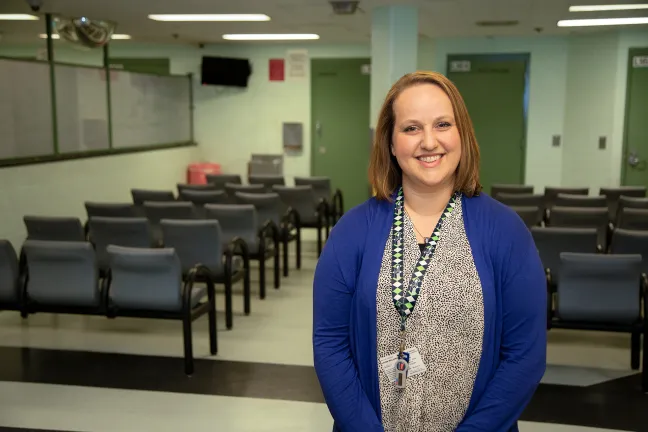The Multnomah County Sheriff announced today that beginning June 1 Corrections staff will distribute the opioid overdose reversal drug naloxone to individuals leaving county jails. The program comes as new data shows people are 15 times more likely to die of an overdose in first seven days after leaving jail.
The distribution is part of a broader partnership with Multnomah County’s Public Health and Corrections Health divisions to reduce overdose deaths and curb recidivism by treating addiction as a chronic illness rather than penalizing addiction as a criminal act.
“We’re trying to save lives,” said Sheriff Mike Reese. “Our goal in public safety is to support the rehabilitation of adults in custody. We believe in a continuum of care that connects people to resources.”
The partnership focuses on initiatives to treat addiction and underlying mental health conditions among people who cycle through Multnomah County jails. The Sheriff has also begun work on peer support and how to expand drug treatment in jail.
“The best outcome is when we seize that opportunity to potentially save a life, but also, to connect people to treatment and end the cycle of addiction and incarceration,” said Multnomah County Chair Deborah Kafoury.
Overdose Reversal
Multnomah County’s syringe exchange program, and in partnership with Outside In, is the region’s largest provider of free naloxone to people who use opioids. Last year alone the programs trained more than 1,000 people on how to administer the drug when someone is experiencing an overdose.
Since launching the distribution program in July 2013, more than 4,000 overdoses have been reversed with naloxone. And 17 percent of those overdoses occurred shortly after people were released from jail or prison. That’s because withdrawal symptoms from a substance abuse disorder can begin within just a few hours of stopping use, causing an individual’s tolerance to previous levels of the drug to plummet, and setting them up for an overdose once they leave the jail. .
Inmates know the risk of overdose increases when their tolerance drops — nurses and counselors in the jail make a point to communicate the risk before release — but addiction isn’t rational.
“When you have a substance use disorder, your brain doesn’t do the things that seem logical. Your brain is telling you not to be sick anymore,” said Erin Browne, manager of the County’s syringe exchange program. “We want to make sure people have the tools not to die when our brains are telling us to do things that don’t make sense. By providing naloxone on release, we’re making sure people have the tools to save their own lives.”
Public Health has for years encouraged the Sheriff’s Office to consider distributing naloxone, and that conversation got a boost after Mike Reese took office in 2016.
“The new sheriff was really instrumental in being supportive of this. He said, ‘Let’s do it! What do we have to do to make it happen?” Browne said. “There was a shift that allowed us to move forward.”
Reese in 2018 joined regional health and justice officials for a summit on the opioid epidemic, and publicly committed his jails to being places where change could begin.
“We can have a profound impact on people in our custody by treating them with dignity and respect,” he said. “You can turn people's lives around, help them to feel self-worth, by showing them human dignity, and still holding them accountable.”
Momentum grew last year as a Health Department team member crunched data to confirm suspicions that people are at greater risk of dying from a drug overdose immediately after leaving prison.
The project manager Tyler Swift paired fatal overdose records from 2009 through 2017 with jail booking data from the same time. His research found that 212 people died of a drug overdose in the year following release from jail, but the risk of death was 15 times greater within the first seven days of leaving detention.
“It’s really stark,” Swift said. “We know that period is essential, and we don’t have time to refer people to go get naloxone. They need it immediately.”
When Swift brought his findings to Reese, he found an enthusiastic advocate.
“There’s a stereotype that corrections is punitive and lacks compassion, and that’s not been my experience,” he said. “There are so many bureaucratic hoops but whenever I’m in a meeting with Mike Reese, he says, ‘What are we waiting for?’ Let’s do it tomorrow!’”
“He’s just like, ‘Let’s do this.’”
Naloxone is safe to use and stunningly effective at reversing an overdose to opioids. It saves lives, just as a defibrillator restarts a heartbeat, an epinephrine pen halts an allergic reaction, or an inhaler relaxes the muscles around the lungs.
Like these other medically-necessary devices, naloxone reacts rather than prevents. That's why it's just one piece of a broader response to addiction. The next question the County is tackling is: What if people who spent time in jail could more readily access medication shown to support recovery from opioid use disorder? That would likely increase the chances they would continue with community-based treatment after release.
Medication-Assisted Treatment
The Sheriff's Office supports expanding medication-assisted treatment for people who are addicted to opioids, but it is still hard for most inmates to access one of the medications most commonly used to stabilize people with an opioid addiction.
Methadone eases symptoms of withdrawal and craving for opioids without producing the unpredictable high associated with illegal drugs like heroin. But state law requires methadone clinics be located at least 1,000 feet from schools and daycares. Ironically, that prohibits Corrections Health, from offering it to patients in their clinics at the maximum security downtown jail.
Oregon Sen. Elizabeth Steiner Hayward this session proposed a bill on behalf of Multnomah County Public Health that would, in addition to expanding access to naloxone, allow local authorities to waive that 1,000-foot rule, giving Corrections Health the option to become a federally-recognized Opioid Treatment Program.
“It would be much easier if we could prescribe it,” said Corrections Health Director Dr. Michael Seale. Instead, Seale relies on a more accessible drug — buprenorphine, a drug given to ease the symptoms of withdrawal. His clinic can also offer buprenorphine maintenance to those coming into the jail already on buprenorphine, as well as initiating buprenorphine maintenance for opiate-involved pregnant women
Individuals booked into Multnomah County jails meet with a team of Corrections Health nurses, who screen about 70 people each day for medical conditions, mental illness and addiction. Pregnant women who report using methadone may continue the drug if an outside provider agrees to come daily to administer the drug.
Otherwise people must undergo withdrawal from opioids or the treatment drug methadone, and are given other medications or buprenorphine to ease the discomfort.
“You give one or two doses and that person feels essentially normal, so it’s humane, effective, probably more cost effective for us,” said Seale.
Even that protocol is relatively new — it ramped up after Seale took over Corrections Health in 2015. He still recalls the first time he prescribed buprenorphine for a young woman withdrawing from heroin.
“She was suffering quite a bit, writhing on the floor, not able to tolerate liquid or food,” he said. A nurse gave the woman a tablet to dissolve under her tongue and left to check on other patients.
“We came back an hour and a half later and she was eating a sandwich,” Seale recalled. “It was a life-changing event for all of us. To watch someone in discomfort be able to tolerate food and liquid, just made believers out of us.”
Seale said Corrections Health sees an increasing number of inmates using buprenorphine as a long-term daily medication to treat a substance use disorder.
“If you’re trying to have a job, bupe is not discovered on most tests, where methadone would be,” he said. “There’s no real euphoria, so it’s easier to tolerate if you’re trying to be productive. We’re seeing a lot of people come in on maintenance levels.”
In those cases, Corrections Health contacts the detainee’s community provider to confirm the prescription, and can then maintain the inmate on buprenorphine throughout their stay. For the average jail detainee, their stay is about two weeks — not long enough to stabilize someone on a routine medication, but long enough to offer a taste of sobriety.
“We have a teachable moment,” Seale said. “It might be the first time someone is accessing medical and mental health care, regular showers, three meals a day, clean clothes. It’s a really good opportunity for us.”
But it can be hard to remain positive about the staff’s ability to make a difference, Seale said. Medication can ease the transition into sobriety, but often people leave jail without the support or stability to make lasting change. He wishes people in jail could connect with community services to address some of the issues that caused the substance abuse.
“You give people pills, but that’s not the treatment of the disorder. It’s just a pill. It’s addressing one issue, but it doesn’t address the factors that led you here. We can enable someone to get onto appropriate medication, but if there’s no follow-up, the chance they’ll continue is quite low.”
Same-day care and peer support
The jail reserves one dorm, called the Treatment Readiness Dorm, for up to 50 people who are committed to recovering from addiction. That program is managed by Volunteers for America. But every day, 30 to 40 people are booked and immediately released, giving corrections staff little time to assess what people might need to keep them from coming back.
Perhaps that’s why the health experts and advocates are excited about an initiative Reese has launched to pilot peer-support and same-day service. In February, Reese reassigned a corrections counselor to work with inmates who are booked and immediately released, usually alleged offenders of minor crimes stemming from mental illness and addiction. They are often given a court date, but then fail to appear.
“So the next time, they’re arrested on a warrant for failure to appear and we can’t release them,” Reese said. “And they spiral into a dark hole.”
Laura Malstrom, a corrections counselor, volunteered for the job. For two months now she has met with individuals to find out what services they might need, be it addiction treatment, mental health counseling, housing support or a food box.
“I like helping people in transitions, and people need help connecting to services so they can stop coming back,” Malstrom said. “It’s been a lot of learning and trying to build our resources so I have more options for referrals. This isn’t an area that has typically had service providers.”
Once Malstrom connects with a person who wants help, she contacts one of two nonprofits. Central City Concern will meet individuals who would benefit from intensive case management, including assistance navigating the court system, getting into treatment and seeing a primary care provider.
“We can’t make that charge go away but we can assist that individual, reduce the chance they fail to appear, make sure they’re working with their probation officer, public defender, providing case management so they can get into service,” said Karen Kern, director of Substance Use Disorder Services at Central City Concern. “It’s about how do we make that case not turn into something worse?”
Malstrom can also call the Mental Health and Addiction Association of Oregon. The nonprofit will send a peer support specialist to meet the individual being released, and take them directly to care. Most often they go either to CODA Treatment Recovery or Cascadia Behavioral Healthcare's Urgent Walk-in Clinic.
The peer support specialist will go along with them, making sure they get what they need before scheduling a follow-up visit. That might be attending a court appearance or a recovery meeting.
“When you walk out the door and someone is there waiting for you, we can let them know we offer peer support and start to build that connection,” said Reina Bower, program manager at the Mental Health and Addiction Association of Oregon. “We bring lived experience to the table. It feels safe and it’s about getting vulnerable.”
Sometimes, the individual isn’t ready to change, and the nonprofit focuses on harm reduction, accessing naloxone and connecting the individual to a syringe exchange program.
But wherever they are on that road to recovery, when someone with a substance abuse disorder walk out of jail, Sheriff Reese wants them to have options.
“Not everyone needs to get incarcerated to change their life, but you meet people where they are. We want to leverage that moment of sobriety that jail offers to give that person a different choice,” Reese said. “To let them know, ‘We want to help. You’re sober today. Do you want to change your life?’”
Related documents



